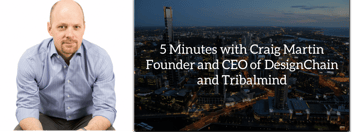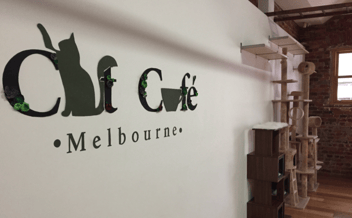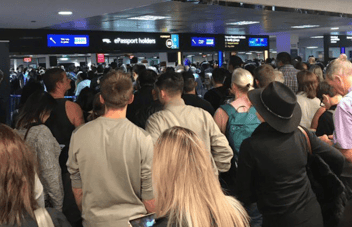Craig Martin is the Founder & CEO of DesignChain and Tribalmind, and is a non-executive director of Knotion Consulting, an African based strategy and architecture services firm. With a career spanning 20 years in consulting, business innovation and development, ranging from large scale projects to launching and designing new businesses that have grown and been acquired. As a business owner and architect he has a keen understanding of both the business challenges and the challenges of the architecture discipline in delivering against these.
It looks like you are a very busy man and you work for a multitude of organisations. How do you explain to a lay person what you do?
I like to see myself as a super mixer. I believe the future of business, and our discipline, is diversity, and the means to mix that diversity in different ways to solve challenges. I have 3 businesses of my own in both Africa and Australia and recently hung up my spurs as the chief architect for Enterprise Architects (Australia) and FHO (Global). It sounds a lot, but in reality the biggest challenge for me is the cognitive switching that needs to occur multiple times during the day, other than that I enjoy the juggling of multiple things. I believe this is foundational for an architect, they need to be good jugglers and be able to operate across the chaos to simple spectrum, finding better ways to drive out new outcomes.
The companies are quite diverse and vary from design, to integration, to architecture, agile and gamification, as well as digital economies. Its therefore quite difficult to wrap it all up in one description. I think that my standard answer when asked is that I am an entrepreneur. And I use the discipline of design and architecture to be a better entrepreneur.
What are your priorities for the year ahead?
Identifying innovative business models for the DesignChain brand. I’m tired of traditional consulting models and I’m sure the market is as well. There are a few interesting options which I am hoping to prototype.
To extend the discipline of enterprise design, mixing design thinking with architecture and agile thinking, using the DesignChain brand. This means completing the visual book on the topic and developing a series of videos and courses on using some of the newer techniques to try and design businesses for disruption.
When you’re consulting with a client, what problem are you trying to solve?
Its twofold, the problem the client thinks he has, and the problem I think he has. This is always the challenge for me, and I daresay a number of other architects. Learning to take the client along for the ride is often one of the more bigger challenges. In most situations its trying to elevate the thinking of the client out of the delivery and tactical space and more into strategic and visionary layers. There is a culture of knee jerk reactions and delivery only, and I find we have to take clients on journey to try and help them take a little longer in understanding the problem space and then looking for disruptive business models or hypotheses to address these. Some of the more recent ones here have related to developing digital strategies for finance sector, industrialising legal services at a global scale, smart city business models, identifying emerging technology trends and impacts on future business models.
What are the current developments in enterprise architecture in technology-centric businesses?
They are quite diverse, but I think the one to watch is the IBP trend we are trying to drive but are also witnessing. IBP (integrated business planning) is when you combine multiple disciplines into a cohesive planning unit. Often methods like capability based planning are pretty one dimensional and focus on a functional decomposition of the business with a technology view or a process view, or perhaps a people view. However, seldomly are these efforts combined into a single discipline. This is the super mixing that I refer to, where, under the guidance of an enterprise planner / EA (whatever you call it), we glue all the aspects of people, process, technology, information, projects, strategy, funding together into one approach. This is cohesion in the planning space, we do this right and we get cohesion in the business space.
What’s your advice to others who are interested in a career in Design thinking and Architecture?
Avoid design and architecture books and read books about economics, ecosystems, social systems and biological systems. These help shape your thinking for the chaos and complexity space. Then complement it with the more analytical thinking books and tools in the architecture space.
Never be satisfied with the status quo. Your job is to challenge and change. Sometimes this is painful, for you and your stakeholders.
If u can – start in the business not in IT. Then equip yourself with design and architecture skills to help you delivery consistency and reliability. Value engineering and management as well as business design and architecture would be a better place to start before you head into TOGAF type worlds.
What technological innovations have made the biggest impact to the business that you consult to over the last 10 years?
The compression of time and space with the advent of new digital technologies. This has allowed people and services to be “closer” to each other and allowed us to connect with people and services faster. Resulting in new disintermediation business models and economic forces similar to how the railroads and general coal powered stream technology changed the world not too long ago. It also means that space and time are now too small and fast for any single person to have control of, resulting on complex ecosystems and connectedness. Those organisations that are able to harness this interconnectedness are the ones that will prosper.
I am also convinced that the Blockchain phenomenon is going to revolutionise the world. It is a major disruptor at all levels, from ecosystem down to protocol and security levels. We have begun to shift a lot of our consulting focus to helping customers understand and apply this technology. I think the most disruptive aspects are the DAO’s (decentralized autonomous organizations), fully automated and encoded digital businesses with all of their processes and rules captured in smart contracts and algorithms. This is a perfect domain for the complex disciplines of architecture to design businesses and ecosystems at the autonomous level, its been my dream for a long time to enable this and its finally happening.
What do you see as the main challenges technology leaders currently face? Is it the technology or the people?
Its both. I think its the ability for people to adapt to technology. Its the partnerships of tech and people that is in fact the challenge, resulting in a greater focus on the disciplines of user experience and customer experience.
Which country is leading the way with Architecture innovations and how does Australia measure up?
I like the thinking that comes out of Holland. Its fresh and challenging and I find them a little ahead of the pack on this front. I think Australia is a bit behind because they have not had the type of adversity required to both innovate, and realise the value of the architecture discipline and what it can bring to the table. As an example I get this type of statement from tier 1 type businesses. “Last year we made more money than in the entire history of this company, why do we need architecture”. This type of thinking is quite apparent in the Australian market. My response to the above question BTW was “why did it take you so long?”. Michael Dell said it quite well “You must innovate when the times are good, you must drive to be relevant every day”.
What’s the best piece of innovation you have seen in recent times and why?
Innovative business models are normally the ones that excite me – Cirque du Soleil for example is a cultural phenomenon that changed how the world saw a circus. You can see value system engineering in this model, where they looked broader into the value system of entertainment and combined aspects of the traditional circus with opera, ballet, theatre, street performance to create an entirely new experience.
When it comes to technology I’m a big fan of AI and I have seen some fantastic advancements in the AI algorithms around swarm and genetic engineering. I believe this is the future of business and the future of software development. IT will touch most of us predominantly in the area of software development, you are beginning to see small pieces of this emerge in the public domain through companies such as grid.io but expect to see a whole lot more.
I also believe the Blockchain is going to usher in the next evolution of the internet, moving us away from the information age into the value age. This technology is so disruptive it will affect almost any form of centralisation, from big banks, to government to Facebook and Google. It truly is a massive disruptor and I’m excited to see the new business models that will emerge as Blockchain begins to gather more and more momentum.
What are your strategies to stay ahead of the competition?
Avoid complacency. Apply joys law and tap into the external market for ideas that can complement your business. Create a way to co-design across your organisation and external to your organisation.
You are well travelled. During your travels what was your favourite place to travel to and your favourite local food?
Believe it or not this was the more difficult question to answer. I’m one of those that sees food as a utility to stop me from feeling hungry. It does not interest me and I seldom focus my attention on where and what I am going to eat. If I have to pick I would say the best meal I have had with the greatest memories was an oyster pot in the small town of Brugge in Belgium.
I know you read a lot, what is the best business book you have read of late and why?
I am a huge fan of Roger Martin and Daniel Pink. Roger Martin’s “The Design of Business” has shaped a lot of my thinking as well as Pink’s “Whole new Mind” and “Drive”.
The Essential Advantage was also great read from the Booz and HBR crowd.
I’m currently reading “The Greatest Business Decisions of all Time” and “The Connection Algorithm”.
Interviewed by Andrew Blades




